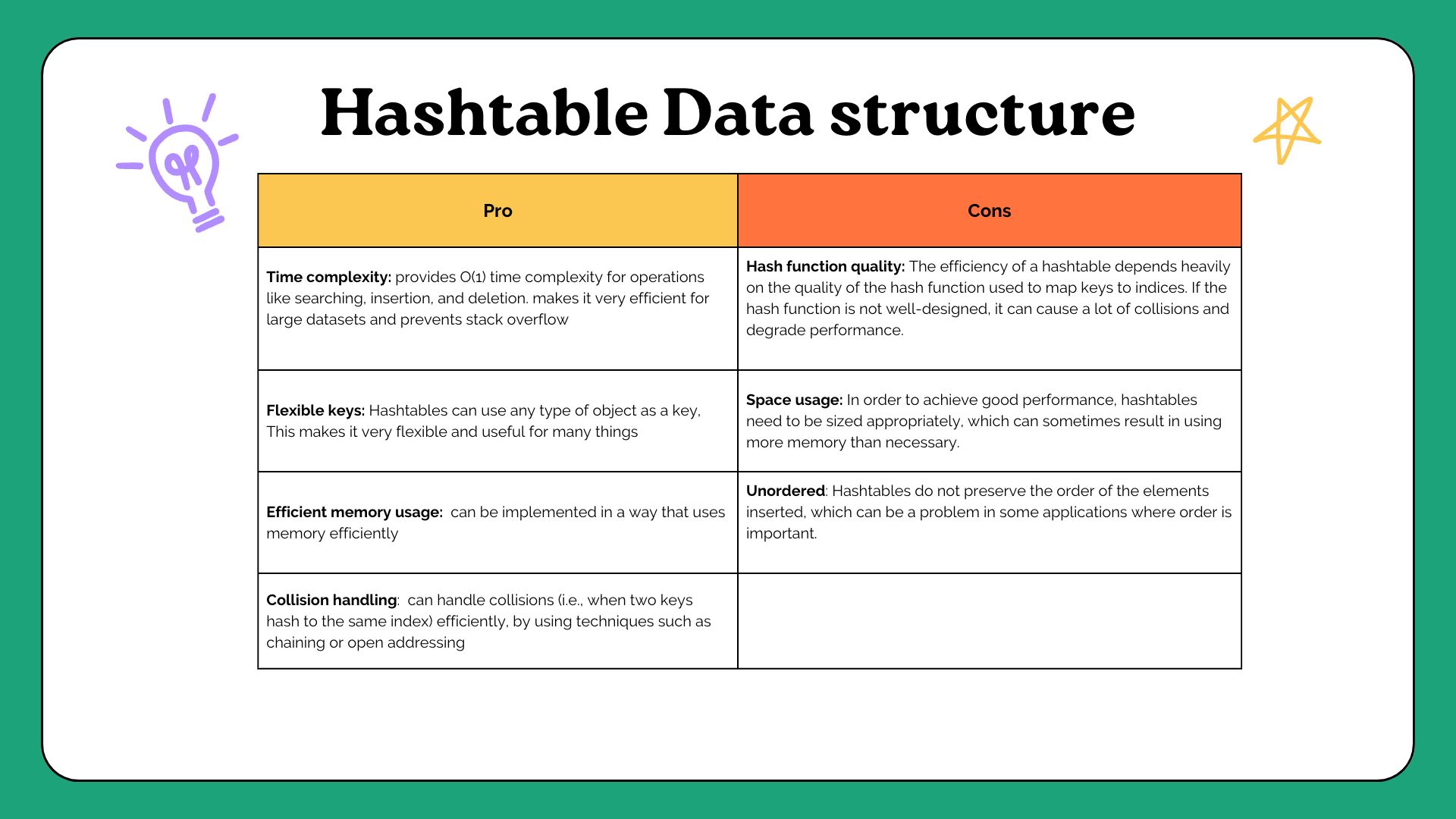Data Structures- Hashmaps, Sets, Hash Tables, Hashing and Collisions
Observing hashmaps with python dictionaries
What is a Hashtable/Hashmap?
A hashtable is a data structure with a collection of key-value pairs, where each key maps to a value, and the keys must be unique and hashtable.
- In Python there is a built in hashtable known as a dictionary.
The primary purpose of a hashtable is to provide efficient lookup, insertion, and deletion operations. When an element is to be inserted into the hashtable, a hash function is used to map the key to a specific index in the underlying array that is used to store the key-value pairs. The value is then stored at that index. When searching for a value, the hash function is used again to find the index where the value is stored.
The key advantage of a hashtable over other data structures like arrays and linked lists is its average-case time complexity for lookup, insertion, and deletion operations.
- The typical time complexity of a hashtable is O(1).
What is Hashing and Collision?
Hashing is the process of mapping a given key to a value in a hash table or hashmap, using a hash function. The hash function takes the key as input and produces a hash value or hash code, which is then used to determine the index in the underlying array where the value is stored. The purpose of hashing is to provide a quick and efficient way to access data, by eliminating the need to search through an entire data structure to find a value.
However, it is possible for two different keys to map to the same hash value, resulting in a collision. When a collision occurs, there are different ways to resolve it, depending on the collision resolution strategy used.
Python's dictionary implementation is optimized to handle collisions efficiently, and the performance of the dictionary is generally very good, even in the presence of collisions. However, if the number of collisions is very high, the performance of the dictionary can degrade, so it is important to choose a good hash function that minimizes collisions when designing a Python dictionary.
What is a Set?
my_set = set([1, 2, 3, 2, 1])
print(my_set)
# What do you notice in the output?
# there are no duplicates. each type of number is outputted only once
# the numbers are outputted in increasing order 1,2,3
# Why do you think Sets are in the same tech talk as Hashmaps/Hashtables?
# they are in the same ted talk because datastructures and hashtables also do not permit duplicates
lover_album = {
"title": "Lover",
"artist": "Taylor Swift",
"year": 2019,
"genre": ["Pop", "Synth-pop"],
"tracks": {
1: "I Forgot That You Existed",
2: "Cruel Summer",
3: "Lover",
4: "The Man",
5: "The Archer",
6: "I Think He Knows",
7: "Miss Americana & The Heartbreak Prince",
8: "Paper Rings",
9: "Cornelia Street",
10: "Death By A Thousand Cuts",
11: "London Boy",
12: "Soon You'll Get Better (feat. Dixie Chicks)",
13: "False God",
14: "You Need To Calm Down",
15: "Afterglow",
16: "Me! (feat. Brendon Urie of Panic! At The Disco)",
17: "It's Nice To Have A Friend",
18: "Daylight"
}
}
# What data structures do you see?
# strings, integers, list, dictionary
# Printing the dictionary
print(lover_album)
print(lover_album.get('tracks'))
# or
print(lover_album['tracks'])
print(lover_album.get('tracks')[4])
# or
print(lover_album['tracks'][4])
lover_album["producer"] = ['Taylor Swift', 'Jack Antonoff', 'Joel Little', 'Taylor Swift', 'Louis Bell', 'Frank Dukes']
my_set = set(lover_album["producer"])
print(my_set)
# What can you change to make sure there are no duplicate producers?
#use the "set" syntax to remove duplicates
lover_album["tracks"].update({19: "All Of The Girls You Loved Before"})
# How would you add an additional genre to the dictionary, like electropop?
#use 'append'
lover_album["genre"].append("electropop")
# Printing the dictionary
print(lover_album)
for k,v in lover_album.items(): # iterate using a for loop for key and value
print(str(k) + ": " + str(v))
print("Title:", lover_album["title"])
print("Artist:", lover_album["artist"])
print("Year:", lover_album["year"])
print("Genre:", ", ".join(lover_album["genre"]))
print("Tracks:")
for track_number, track_title in lover_album["tracks"].items():
print(" {}: {}".format(track_number, track_title))
def search():
search = input("What would you like to know about the album?")
if lover_album.get(search.lower()) == None:
print("Invalid Search")
else:
print(lover_album.get(search.lower()))
search()
# This is a very basic code segment, how can you improve upon this code?
# Add more functionality to the search function by allowing the user to search for specific information within the dictionary (e.g. album title, artist, year, genre, tracks, etc.) instead of just searching for a specific key.
# Use more descriptive error messages to help the user understand why their search was invalid
- Build your own album showing features of a python dictionary
vivian_album = {
"artists": ["The Weekend", "Billie Eilish", "Joji", "keshi", "Rex Orange County", "SZA", "clairo", "Taylor Swift"],
"genre": ["Pop", "indie-pop", "lofi", "Rap"],
"tracks": {
1: "After Hours",
2: "Cruel Summer",
3: "Sanctuary",
4: "Its You",
5: "Summer",
6: "Amazing",
7: "Best Friend",
8: "Kill Bill",
9: "Snooze",
10: "Amobea",
11: "Die for You",
12: "Save your Tears",
13: "good girls go to hell",
14: "My Future",
15: "Watch",
16: "Bellyache",
17: "cupid",
18: "sour grapes"
}
}
def print_album():
print("Artists:")
for artist in vivian_album["artists"]:
print(f"- {artist}")
print("\nGenre:")
for genre in vivian_album["genre"]:
print(f"- {genre}")
print("\nTracks:")
for track_number, track_title in vivian_album["tracks"].items():
print(f"{track_number}. {track_title}")
print_album()
My favorite taylor swift song is Cruel Summer because, contrary to the title, it brings back great memories from my summer. I got to meet a bunch of new people at a summer camp that summer and we all got really close because we lived on the UCSD campus together. At the program, there was a dance and we danced so much to Cruel Summer so every time the song plays it's just such a bop and it reminds me of the good times.

